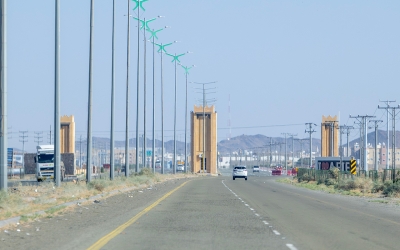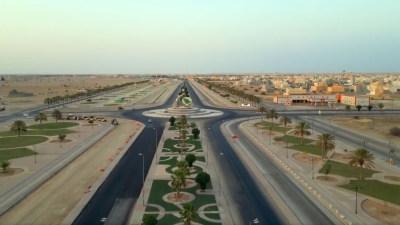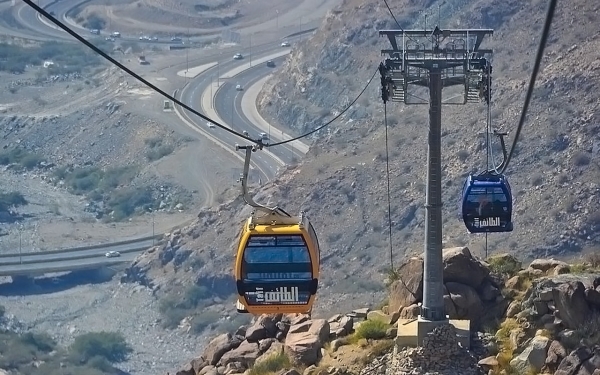
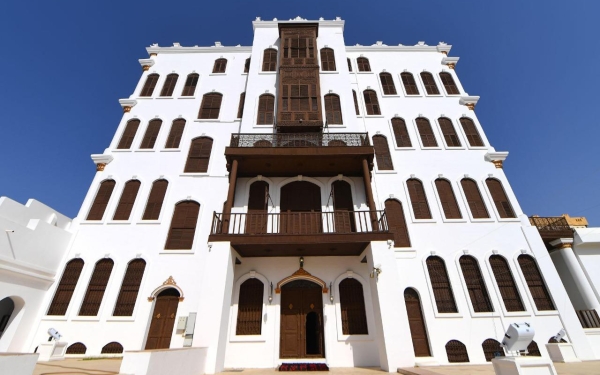
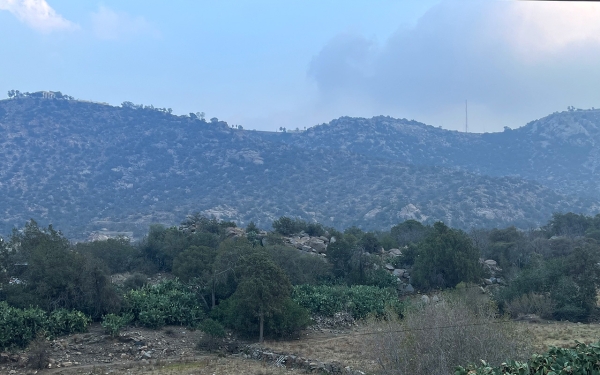
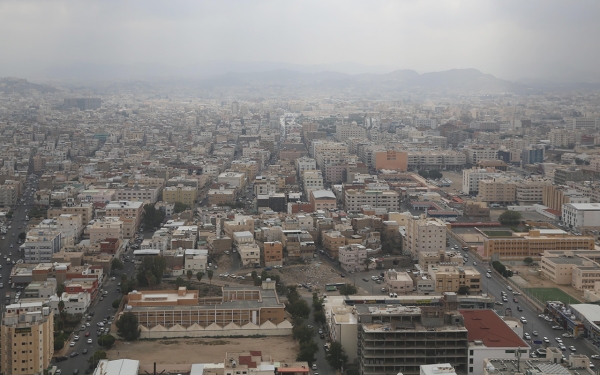
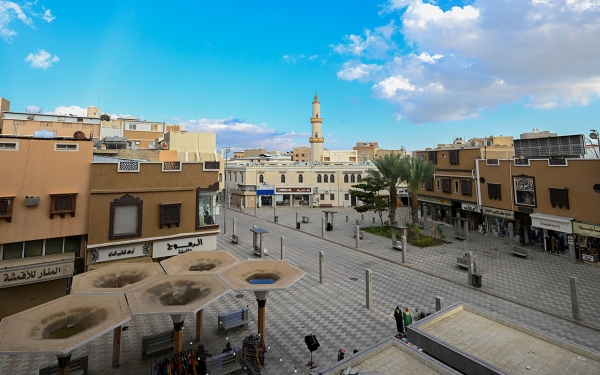
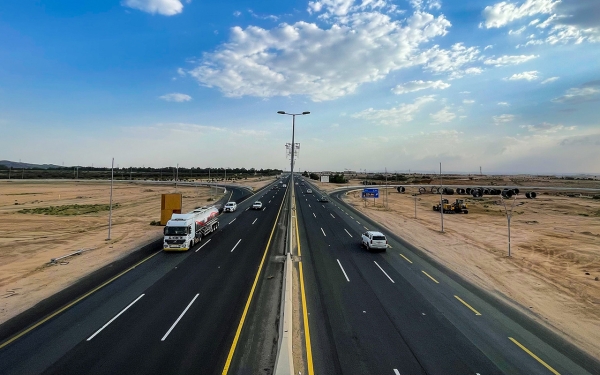
Taif Governorate (romanized: Muḥāfad͟hat aṯ Ṯāʼif) is the largest governorate in Makkah al-Mukarramah Province in the Kingdom of Saudi Arabia and the seventh largest in the Kingdom by area. Located in the western part of the Kingdom, it is a local and regional tourist destination due to its moderate climate. It also serves as a major station for pilgrims and visitors traveling by land to Makkah al-Mukarramah from the east, both from within the Kingdom and abroad. Many residents from the inner regions visit Taif for its mild climate in the summer. The focus on tourism and the availability of services in Taif have led to a significant rise in the number of tourists visiting the area, especially in the last decade.
Also, 99.5 percent of its public spaces are deemed decent, and its quality of life indicators reach 80 percent according to the global scale for urban prosperity. The economy of the Taif Governorate primarily relies on commercial tourism. According to the International Prosperity Index, Taif is rated as 51.2 percent productive and has an employment capability of 72 percent. The military, government, education, health, and social services sectors employ 68.5 percent of the population. The economic growth indicator reaches 68.9 percent.
Taif is an annual cultural destination in the Kingdom, hosting Souq Okaz, the largest and oldest historical event that has continued since the pre-Islamic period. This market attracts visitors from within the region and beyond. It was one of three main markets in the pre-Islamic era where Arabs traditionally met for trade and poetry recitation for twenty days starting from the first of Dhu al-Qa'dah. Pilgrims in the past would also spend time there before heading to Makkah. Today, Souq Okaz serves as a cultural exhibition, hosting cultural and entertainment activities that reflect the past.
A historical overview of Taif
The naming of Taif
In ancient times, Taif City was inhabited by the Banu Thaqif tribe. They constructed 'al-Tawf,' a wall that completely encircled the city. This fortification was built to protect its inhabitants and safeguard the city's wealth from enemies. Al-Damun Ibn Abd al-Malik al-Hadrami advised them to build the wall, fearing revenge after fleeing from his people for killing one of his cousins. The name 'Taif' in Arabic means 'comprehensive'. Taif City has been known by several names, including Waj, named after Waj Bin Abdul Hayy, an inhabitant from the Amalekites. Other names for Taif are Diyar Thaqif, al-Qarya, Ihda al-Makatayn, and al-Hadaba.
The historical importance of Taif
In modern times, the name Taif comes to mind when discussing political work to resolve conflicts. It was in Taif that the end of the Saudi-Yemeni War was announced in 1934 under the 'Treaty of Taif.' Additionally, the 'Taif Agreement' of 1989, also known as the National Reconciliation Document, was formulated there, setting the framework for building the civil Lebanese state and marking the end of the Lebanese Civil War.
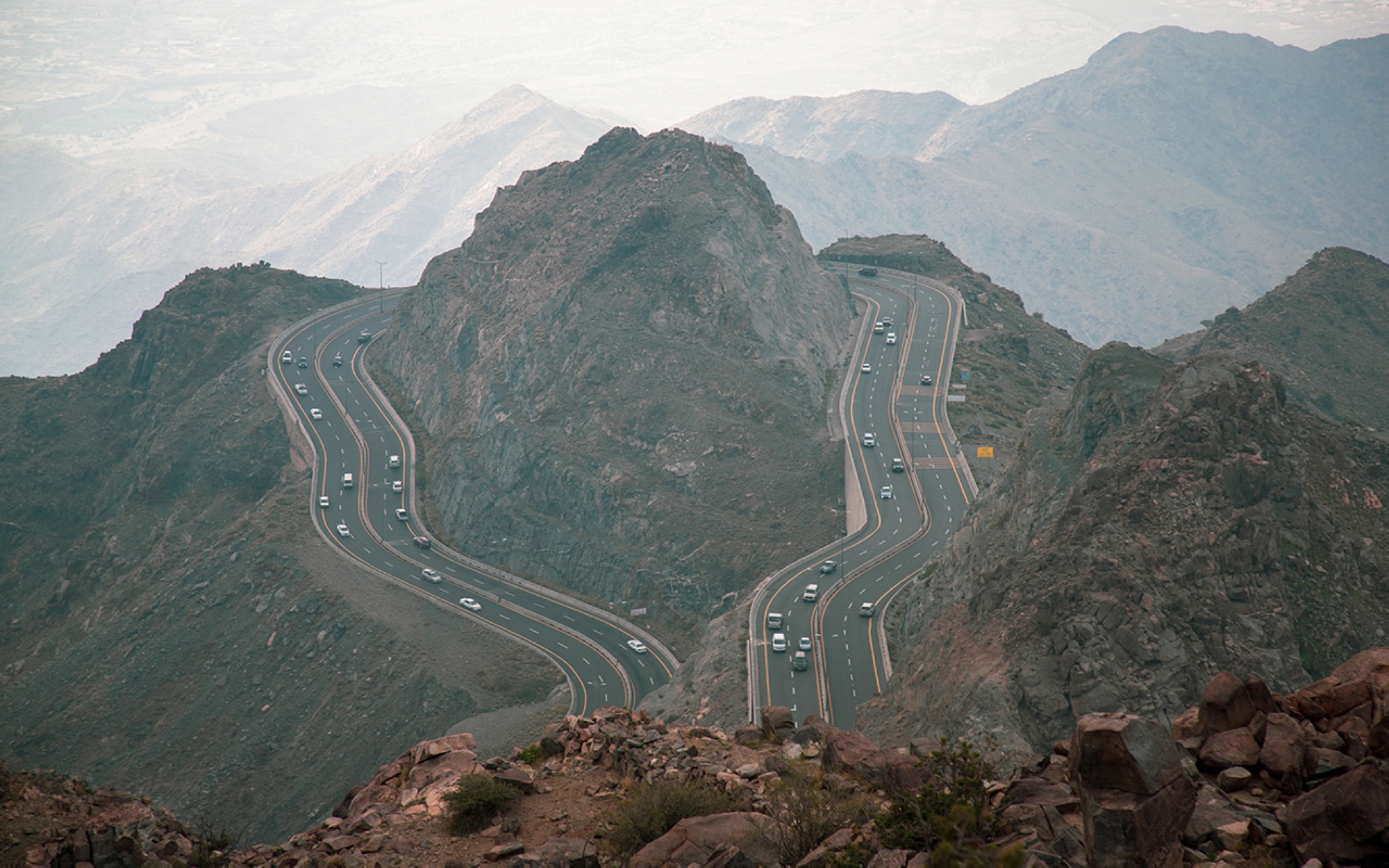
Geography of Taif City
Location and borders
The Taif Governorate is located in the central-eastern part of the Makkah al-Mukarramah Province, west of the Kingdom. It lies between latitudes 19-20/0-24 North and longitudes 10-50/40-42 East, at an elevation of 1,800 m above sea level on the eastern slopes of the Sarawat Mountains. To the north, it is bordered by Mahd adh-Dhahab Governorate, which is administratively affiliated with al-Madinah al-Munawwarah Province. To the south, it is bordered by al-Lith Governorate and al-Bahah Emirate. To the east, it is bordered by the Afif Governorate, administratively affiliated with Riyadh Province, as well as Turubah and al-Khurmah Governorates. To the west, it is bordered by al-Kamil and al-Jumum Governorates and other administrative centers affiliated with Makkah al-Mukarramah Province.
The weather in Taif
Geographically, Taif Governorate is situated at an elevation of 1,800 m above sea level, resulting in a climate with moderate temperatures in summer and lower temperatures in winter. The minimum temperature in winter can reach around three °C, with a maximum of around eighteen °C. In summer, the temperature increases slightly but does not exceed an average of thirty °C. July is usually the hottest month, with an average temperature of 27.1 °C, while January has the lowest average temperature during the year, dropping to about 13.9 °C.
During spring, rainfall is caused by the moist southwestern winds originating from the African continent and passing through the Red Sea, contributing to 47 percent of the total annual precipitation. However, in the summer, which is typically a dry season in the region except for Taif City, rainfall occurs at a rate of 14 percent due to the city's high altitude. The southwesterly winds gain influence during the summer season.
Demographics of Taif
The population of Taif Governorate has increased over the past decades from four hundred thousand people in 1992 to more than half a million people in 2004. By 2010, the population had reached 580,000 people. According to the latest census, 'Saudi Census 2022,' the population of the governorate is approximately 913,374. There is a significant youth population in Taif, with about 50 percent of the population under the age of thirty. It is projected that by 2030, the population of Taif City will reach around 1.5 million people.
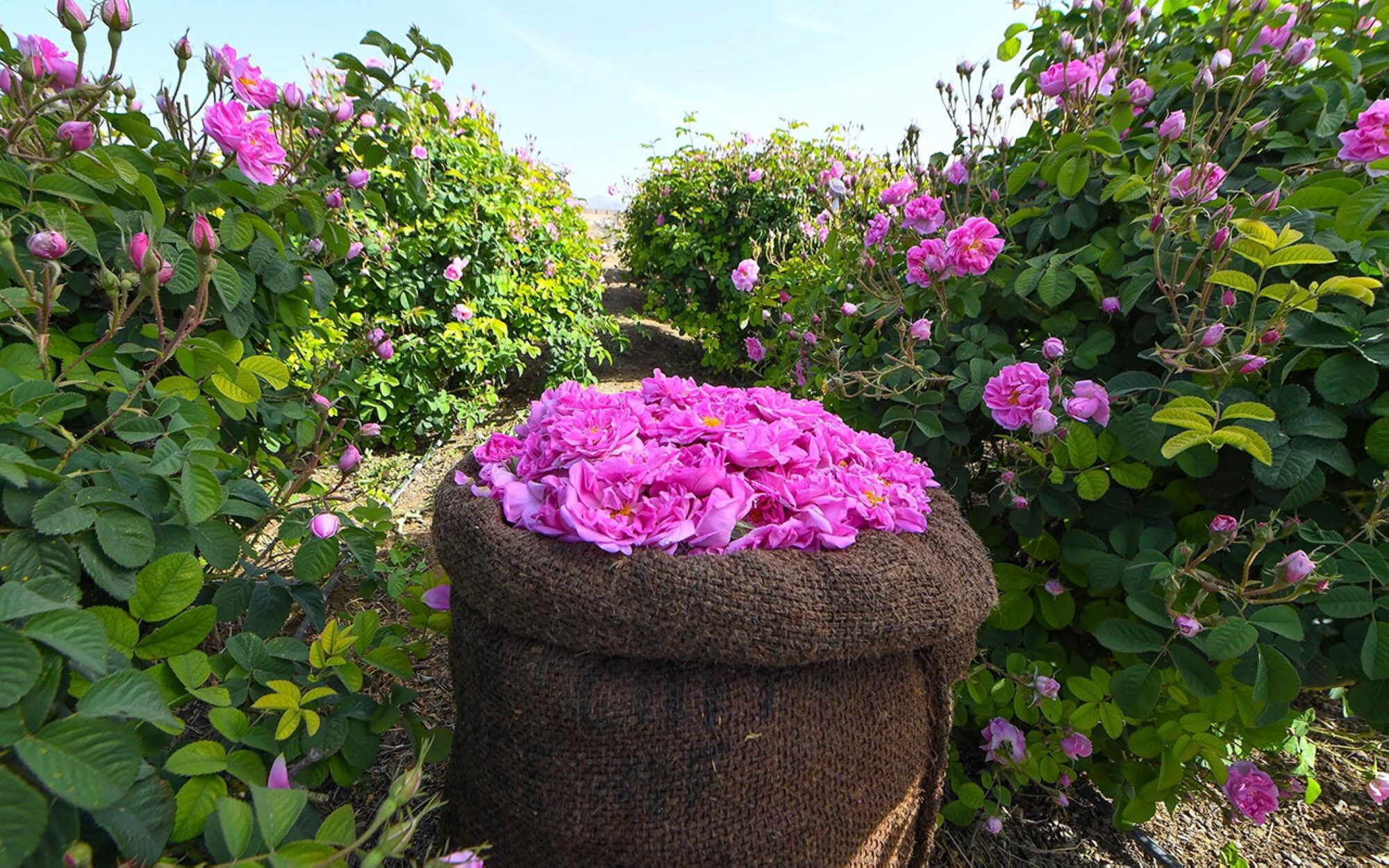
Agricultural wealth in Taif
Rose cultivation
Taif stands as the Kingdom's rose hub, yielding approximately 650 million roses each year. It hosts over seventy distillery production factories and workshops dedicated to Taif's rose industries. The cultivation of roses in Taif begins in December. By mid-January, the rose bushes are pruned in preparation for the blooming season in spring. The harvest season for Taif roses commences at the end of March. Taif is famous for cultivating two types of roses: the first is the Taif rose, characterized by its light red color and strong fragrance, and the second is the deep red rose. Rose cultivation in Taif takes place in elevated areas within the governorate, specifically in the centers of al-Shafa, al-Hada, Wadi al-A'amq, Wadi al-Bani, Wadi Muhram, as well as in the regions of Tuwairiq and al-Makhadah. In 2022, the Kingdom set a Guinness World Record during the second edition of the annual Taif Rose Festival for creating the Taif Rose Basket, surpassing the record previously held by a rose basket made in Singapore in 2018.
The production of Taif rose water occurs during the rose-picking season. About thirteen thousand roses are placed in a special pot, and a fire is lit underneath until steam begins to form. This steam then travels through a tube in the pot's lid to a container filled with water. The steam cools and condenses, with droplets forming in a collection vessel. Rose water is then extracted after adding a quantity of fresh water or water from al-Aroos rose.
Seasonal fruit cultivation
Seasonal fruits are known for their high quality and delicious taste, which makes them popular among locals and tourists. In Taif City, farms cultivating seasonal fruits are widespread along valley banks, highlands, and mountain slopes. These farms grow various fruits, such as berries, apricots, plums, peaches, and apples. Among the most famous seasonal fruits in Taif is the prickly pear, particularly abundant in al-Shafa highlands. Sales points for prickly pear are widespread along roads and in public places. Its annual production is estimated at around 1,200 t. Another notable seasonal fruit produced in Taif farms is the fig, locally known as 'al-Hamat.' The cultivation of figs is widespread in the area, with the number of fig trees exceeding twenty thousand. Its production from the beginning of June to the end of August exceeds five hundred t. To increase agricultural crop production, the office of the Ministry of Environment, Water, and Agriculture in Taif provides services to farmers, including guiding them and informing them about the importance of using modern irrigation methods, combating agricultural pests, and spraying crops to protect them from pests.
Cultural landmarks in Taif
Historical palaces
Mishrefah Palace
Mishrefah Palace is located north of Souq Okaz and dates back to the early Islamic era. According to studies conducted in the area, it was found that there were indications of settlement in the prehistoric period. Two mountains connected with a wall and located about five km south of Souq Okaz have been discovered. The wall is approximately three hundred m long and two m wide. The palace includes a number of sites with rock art, as documented by archaeological surveys. These artworks include human and animal figures, such as scenes depicting the hunting of mountain goats using hunting dogs, battle scenes with bows and arrows, various symbolic drawings, and images of cattle with forward-facing horns.
Shubra Palace
It is a museum and historical landmark distinguished by an architectural style that blends Islamic, Roman, and traditional Hejazi architectural methods. It was named after a palace in the Shubra District of Cairo, from which its design was inspired. The palace was built in 1905, and its construction took two consecutive months. It features four facades interspersed with columns made of lime and stone. The doors and windows are crafted from wood and adorned with artistic touches. It served as a summer residence for the government during the reign of Founding King Abdulaziz Bin Abdulrahman Al Saud. During the reign of King Faisal Bin Abdulaziz Al Saud, it became the headquarters of the Ministry of Defense and Aviation, and later it was transformed into a museum for antiquities and heritage in 1988.

Al-Kaaki Palace
This historic palace was built in a Roman architectural style by the builder Mohammed Bin Othman al-Qurashi in 1939. The construction took two years to complete, covering an area of 1,275 m. The palace is surrounded by a garden that grows fruits, vegetables, and flowers. It consists of three floors and includes forty rooms and six kitchens. Additionally, there is a well that used to provide the palace with fresh water. Al-Kaaki family, including Sadaqah al-Kaaki and Siraj al-Kaaki, resided in the palace. Later, it was rented out during the summer periods.
Al-Kateb House
It is one of the historical palaces constituting the heritage of Taif City. It is known as the 'al-Kateb House Palace' or 'Kasr al-Nyaba.' It was used as a residence by King Faisal Bin Abdulaziz Al Saud during the summer period. The palace was constructed by Mohammad Ali Abd al-Wahid and took three years to complete. In 1930, it was inhabited by the children of Mohammed Ali Abd al-Wahid after its restoration and the repair of any damages. A separate annex was also built next to it on the eastern side, constructed from stone and clay. Al-Kateb's Palace consists of three stories built in the ancient Roman architectural style. It also features a spacious courtyard and a garden where fruits and vegetables are grown. The palace is distinguished by the presence of many diverse stone, gypsum, and plaster sculptures of various shapes and sizes. These sculptures depict drawings, images, and geometric shapes of animals and plants, reflecting the natural environment of Taif.
Jabra Palace
The Jabra Palace is located in the northeastern part of Taif City, on Wadi Wajj, near the area where the Battle of Hunayn took place. It is the same area where Lady Zubaydah, the wife of Harun al-Rashid, initiated the Ain Zubaydah project, which involved diverting water from wells and springs to Makkah al-Mukarramah to provide water for pilgrims. The palace was named 'Jabra Palace' after Lady Jabrah of the Makhzoum tribe, the wife of the Emir of Makkah, Mohammed Bin Hisham, who was one of the princes during the Umayyad era.
The palace has three floors and a large hall, which was built by King Abdulaziz Bin Abdulrahman Al Saud in 1943. It also includes many rooms, a basement, and an entrance adorned with beautiful decorations. In the center of the palace courtyard, there is a water fountain.
Historical centers (Taif Historical Center)
The central area of Taif comprises three ancient neighborhoods, enclosed by walls on all sides. These neighborhoods include Harat Fawq, situated behind Bab al-Ray, and Harat Asfal, the widest and most populous neighborhood, located behind Bab al-Hazm and inhabited by princes and nobility. Additionally, there is Harat al-Sulaimaniyah, located near Bab Ibn Abbas. Those entering through this gate would encounter Harat al-Sulaimaniyah on their right. It was renowned for 'Hamam al-Shafa,' an architectural landmark in its structural components. It once housed a significant number of heritage houses and markets, but they were removed during modern expansion in 1983. As for Fawq Neighborhood and Asfal Neighborhood, they still retain the left sides of the buildings. Near the wall, there are several suburbs, including Qarawi Suburb, al-Salamah Suburb, al-Mathnah Suburb, Maashi Suburb, and al-Aziziyah Suburb, which was newly established. A project to develop the historical center of Taif has been initiated by Taif Municipality.
Historical mosques
Al-Qantara Mosque
One of the historical mosques in Taif City is named after its location in front of a bridge that connects the northern bank to the southern bank of Wadi Waj. It is also known as al-Madhoun Mosque because it was built on the slope of Madhoun Mountain. It was constructed during the reign of Sharif Abd al-Muttalib Bin Ghalib, the Emir of Makkah, in 1846. It is located in al-Mathnah Neighborhood on the main street of Wadi Waj. The mosque has a length of approximately seven m and a width of about twelve m. It features a rectangular hollow mihrab that is elevated about one and a half m above the mosque's floor. The mosque is constructed using stone, red bricks, and wood. It has a projecting roof that leans forward, allowing rainwater to flow from its surface. There is a minaret in the shape of a turban, cylindrical in shape and tapered, resembling the minarets found in the Abbasid era in the Great Mosque of Samarra and the Mosque of Ahmad Ibn Tulun in Egypt. Access to the minaret is via a spiral staircase.
Mosque of Abdullah Bin Abbas
It is located at the foot of Mount al-Madhoon in Taif. The construction of this mosque is attributed to Abdullah Bin Abbas, may Allah be pleased with him, upon his arrival in Taif. However, the current building of the mosque dates back to the late Ottoman rule It is approximately square in shape, with a rectangular courtyard at its back, accessible from the southern end of the eastern wall. As for the mosque, it is accessible through a door in the middle of the eastern wall of the mosque. It is adorned with two rectangular windows. The mosque is divided into two prayer areas separated by a wall with three intertwined arches. The mihrab is located in the middle of the western wall, aligned with the entrance door. It has a concave shape and is topped with intricate details. It protrudes about one m from the wall's exterior. The deterioration suffered by the northern wall of the mosque is noticeable. The grave of Abdullah Bin Abbas, may Allah be pleased with him, is locate in the southwest part of the mosque.
The Taif region includes a group of historical mosques located along the sides of al-Mathnah Road in Wadi Waj, such as the mosque of Masjid Adas, which is situated amidst the orchards at the foot of Abu al-Akhailah. It is named after Addas, the Christian, who was the first person from the people of Taif to believe in the Prophet, peace be upon him (PBUH). The mosque was built at the location where the Prophet (PBUH), stood when he preached to the people of Taif. Al-Mawqif Mosque, or al-Kou Mosque, earned this name because it is believed that the Prophet (PBUH) either stood or leaned on it. It is located to the right of the road leading to Ekrima Dam in Jabal al-Qurayn. The mosque is approximately eight m long, seven m wide, and three m high, and behind the mosque, there is an open courtyard that measures about seven m in length and four m in width. Al-Khubzah Mosque, located near al-Kou Mosque, is one of the historical mosques that have been restored and renovated using reinforced construction. It has a square shape with a length of approximately twelve m. Moreover, there are several other scattered mosques in the area, such as al-Sidrah Mosque, which is attributed to Prophet Muhammad (PBUH), and also known as the al-Sadirah Mosque. There is also the al-Mahjoub Mosque in al-Salamah Neighborhood and al-Hunud Mosque in the central area.
Historical castles (Marwan Castle)
The historical Marwan Castle is one of the tourist archaeological sites in Taif. It is an ancient stone fortress located in the northeastern part of Taif Governorate, in the historical land of Bani Adwan, in the village of al-Ubaila in al-Hawiyah. The castle was built over four hundred years ago on an elevated site overlooking Souq Okaz and the surrounding villages. It served as the residence of the Emir of Hejaz, Othman al-Mudhayfi al-Adwani, one of the princes of the First Saudi State. It also served as a launching point for him to carry out the orders of the First Saudi State, and he remained its governor for more than ten years.
Dar al-Tawheed School
It is the nucleus of educational schools in the Kingdom. It was the first formal school established by Founding King Abdulaziz Bin Abdulrahman Al Saud in 1944 to graduate judges. Later, it was decided to teach Shariah and Arabic sciences in the school in 1954. It was named Dar al-Tawheed. King Faisal was assigned the task of overseeing the school and connecting it to the royal court, while King Saud was delegated to attend the school's celebrations that King Faisal could not attend.
The school is located in the western part of the central city in the Qurwa Neighborhood of Taif City. It consists of a single-story building constructed with Hejazi-style stone architecture. Taif was chosen to become a bastion of education with the establishment of Dar al-Tawheed School due to its unique geographical location, which connects the Hejaz to Najd and its proximity to Makkah al-Mukarramah. People traveled to Taif for prayers at the Grand Mosque or to perform the Hajj and Umrah pilgrimage. Additionally, its natural environment facilitated the rapid adaptation of students coming from various regions of the Kingdom. Dar al-Tawheed School played a significant role in stimulating literary activity by establishing the literary club.
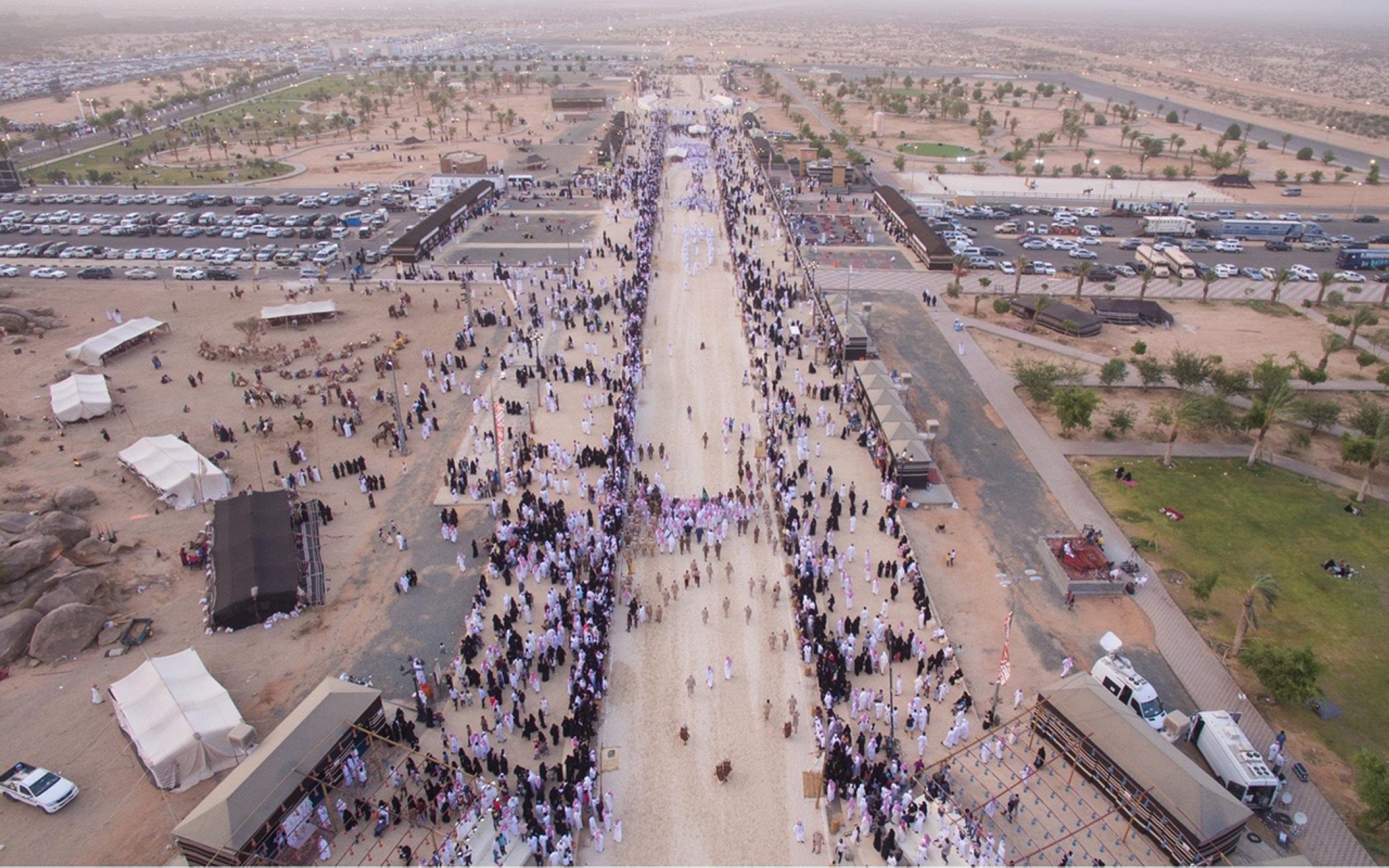
Archaeological sites in Taif
Souq Okaz
Souq Okaz is located north of Taif City and is one of the largest and most famous Arab markets in the pre-Islamic and Islamic eras. It serves as a major station on the Hajj Route, starting from Yemen and passing through Najran, Aseer, and Hejaz. It is a gathering place for Arab tribes and their leaders, who meet once a month for trade, intellectual discussions, literature, diverse culture, and contract documentation. Poets, orators, and intellectuals also convene here, and various sports activities, such as horsemanship, running, and shooting, take place. Some of the most famous scholars and princes who visited Souq Okaz include Rabi'ah Bin Mughashan, Zarrara Bin 'Adas, Damrah al-Tamimi, Aktham Bin Saifi al-Tamimi, Saifi Bin Rabah, and al-Aqra' Bin Habis Bin 'Aqal.
According to historical and literary sources, the history of Souq Okaz dates back to 501. Arabs used to gather there at the start of Dhu al-Qi'dah for twenty days, reciting poetry, bragging, and trading goods before moving to another market. However, it was stopped by the Kharijites after acts of plunder and sabotage. In 2007, the Kingdom revived Souq Okaz after a hiatus of 1,300 years.
Al-Arfaa monuments
Al-Arfaa area is considered an extension of the geographic region of Souq Okaz, located east of Taif. It is one of the largest rock art sites, containing Thamudic inscriptions, Kufic writings, as well as some human and animal drawings, such as goats, deer, and scenes of hunting oryx using hunting dogs. There are also depictions of battles with bows and arrows, images of advancing cattle, and animal drawings dating back to the era predating the second millennium BCE.
Darb al-Jammalah
It is a mountainous road in the form of stairs, paved with stones for pedestrians and camels. It descends from the mountain tops of Taif towards Tihama, reaching Kara. The construction of this road dates back to more than one thousand years ago, making it one of the oldest archaeological roads. Traditionally, pedestrians, pilgrims, travelers, and traders used this path to transport goods on the backs of camels until 1961. This road connected travelers between Taif and Makkah al-Mukarramah for many years. In 1965, a third road in the Darb al-Jammalah was opened for cars, during the reign of King Faisal Bin Abdulaziz Al Saud.
Darb al-Jammala is approximately six km long and varies in width between two and three m. It branches off from one of the old pilgrimage routes, the 'Asba Road.' Pilgrims descend through Darb al-Jammala to al-Kurr, then to Wadi Numan, followed by Arafat, Wadi Uranah, Muzdalifah, Mina, and then to Hawd al-Baqar, which is currently known as al-Aziziyah Neighborhood in Makkah al-Mukarramah.
Al-Waht Village
It is a settlement located west of Taif City, separated from al-Mathnah by the ring road that leads to al-Shafa and Shahar for those coming from Aqabat al-Hada. The settlement includes two cemeteries, one from the pre-Islamic era and the other from the Islamic era. Additionally, fragments of glass and pottery from the Umayyad and Abbasid eras were found. There is also a garden mentioned in historical sources as belonging to Amr Bin al-As, and narrow, circular wells lined with stones.
Water facilities
Dams
Over seventy historical dams were built in Taif City throughout various eras, starting from the pre-Islamic period and extending to the era of the Fatimid Caliphate. Due to the robustness of their construction and the solidity of their walls, more than twenty of these dams in Taif still stand. These include: Ardah Dam, al-Samallagi Archaeological Dam, Ibn Salman Dam, al-Darwish Dam, Quraqir Dam, Wadeema Dam, al-Aqrab Dam, Thalbah Dam, Sa'ab Dam, al-Qusaibah Dam, Sadad Dam, al-Khair Dam, al-Dama Dam, Gharooq Dam, al-Salamah Dam, and Umm al-Baqara Dam.
Saysad Dam
It is one of the ancient historical and archaeological dams in Taif, located about twelve km southeast of the city. The dam measures fifty-eight m in length, 4.1 m in width, and 5.8 m in height. It is known as 'Sadd al-Abad' and 'Sadd Muawiyah.' It was built by Abdullah Bin Sakhr during the reign of the Umayyad Caliph Muawiyah Bin Abi Sufyan in 678. The dam includes inscriptions and writings that are considered the first foundational plaque in the Arabian Peninsula for development projects. The dam was constructed from granite rocks, and the wall was built with large, rectangular-shaped stones.
Al-Samallagi Dam
Al-Samallagi Dam is located in Wadi Thamalah, approximately thirty km southwest of Taif. It is situated between two mountains in a valley abundant with Sidr and Talh trees near the dam's front. The dam is 212 m long, twenty-five m high, and ten m wide at the top. Its storage capacity is estimated to be around half a million m. It is believed to have been built during the reign of Muawiyah Bin Abi Sufyan, and it is known as 'Thamalah Dam' and 'Bani Hilal Dam.' Two inscriptions were found near the dam.
Al-Lasb Dam
Al-Lasb Dam is located south of Taif in Wadi Ardah, to the left of the expressway leading to al-Shafa from Taif. It was previously used to control rainwater and floodwater. The northern part of the dam, which still stands, is approximately forty-two m long, while the length of the southern, collapsed part is thirty-seven m. The height at the highest point in the southern part reaches 5.5 m, and its thickness is 2.5 m. The archaeological findings surrounding the dam indicate the existence of population and urban settlements nearby, which benefited from the dam's water.
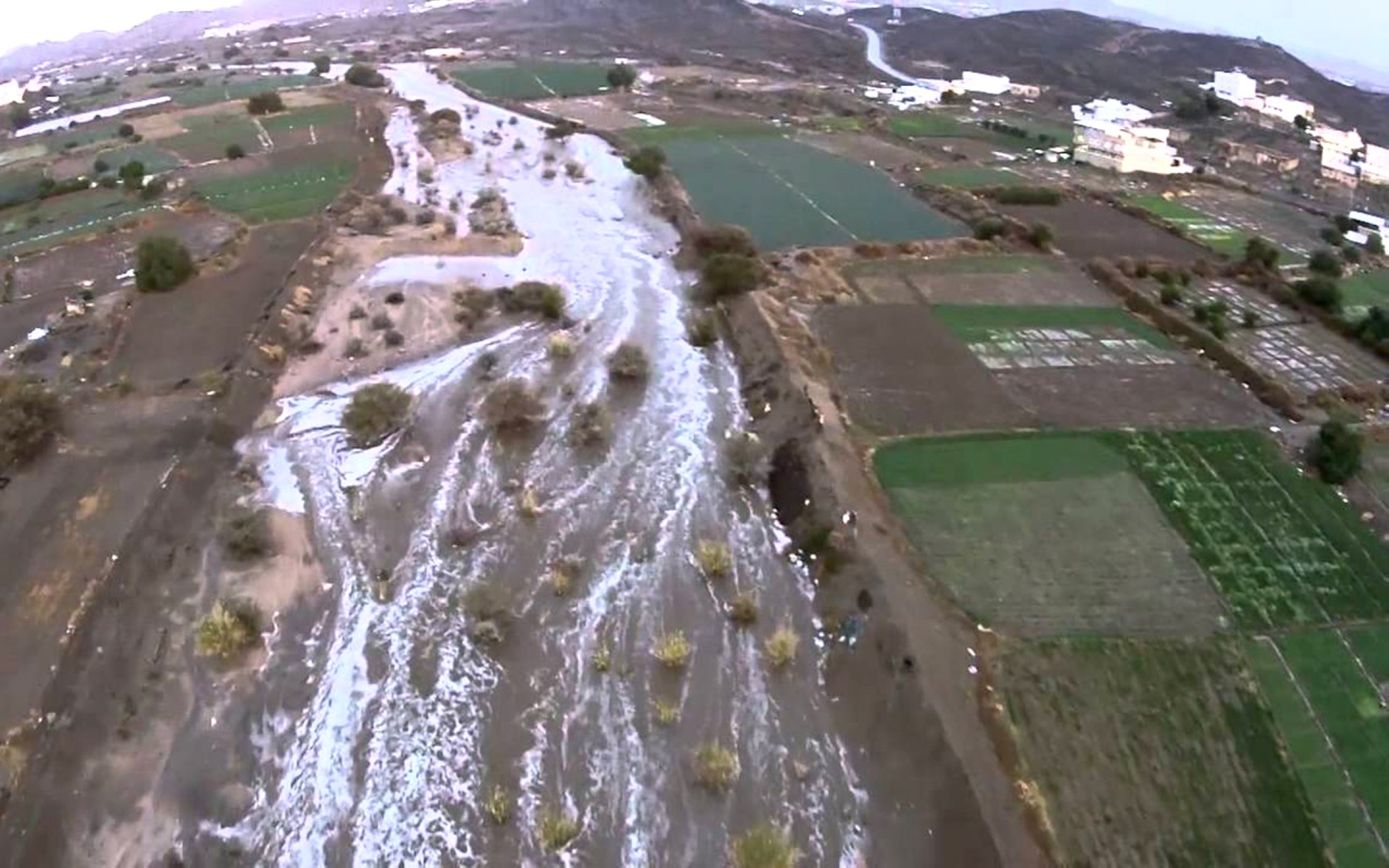
Valleys
Taif City hosts numerous valleys, totaling forty, with the most prominent ones being Wadi Waj, Wadi al-Shafa, Wadi al-Mathnah, Wadi Saydara, Wadi Dhi Ghazal, Wadi Muharram, Wadi al-Qarahayn, Wadi Nakhb, and Wadi al-Waqadeen.
Wadi Liyah
Wadi Liyah is one of the natural tourist attractions in Taif, stretching approximately 120 km in length. Wadi Liyah originates in the northeast and flows towards the southwest, extending across three governorates: Taif, al-Lith, and al-Qunfudhah in Makkah al-Mukarramah Province.It irrigates more than one hundred farms and its flow is dependent on the amount of rainfall. Several valleys and ravines, such as Wadi Afar, Wadi Bani Umar, Wadi Dhi Ghazal, and Wadi Khamas, flow into it.
Wadi Waj
Wadi Waj extends for approximately 230 km, running from the southwest to the northeast. It originates from the village of Hudhayl, affiliated with al-Shafa center in Taif Governorate. It flows into Harat Rukbah, located to the northeast of Taif. It has an average slope of ten m and contributes to the flow of Wadi al-Arj and Wadi Sharb. Wadi Waj is considered one of the fifteen longest valleys in the Kingdom.
Springs
Taif relies on springs as sources for irrigation and agriculture. The water is channeled through canals to facilitate its flow on the surface of the land. Some of the springs in Taif include the springs of Wadi Qarawi, Wadi Jifn, Wadi Qarn, and Wadi Liyah.
Ain al-Wuhait
Ain al-Wuhait is located on the left side of al-Mukhadah Valley. It is one of the historical springs in Taif City. It was built in the early sixteenth century by the Emir of Makkah al-Mukarramah, Sharif Awn al-Rafiq. After it suffered damage due to floods and rain, its ownership was transferred to Taif Water Company in the early twentieth century.
Ain Shubra
It is the oldest archaeological spring in Taif, known as 'Ain al-Salamah' and 'Ain al-Taif.' Its ownership was transferred in the late nineteenth century to the Emir of Makkah al-Mukarramah, Sharif Abdullah Bin Mohammed Bin Abd al-Muin Bin Awn. It was named 'Shubra,' after Shubra in Cairo, and its waters were used for farming areas near 'Bab al-Hazm,' one of the gates of Taif City. It was then sold to a local of Taif named Mohammed Saleh Kashmiri, who repaired and renovated its canal.
Ponds
Ponds are considered important water facilities due to their significant capacity to retain rainwater and floodwater, which are used for drinking and agricultural purposes.
Al-Kharabah Pond
Al-Kharabah Pond is located along Wadi al-Aqiq in Makkah al-Mukarramah Province, about fifty km north of the Ashira Center. It is one of the stations on Darb Zubaydah, serving as both a dwelling and a water source along the Basra pilgrimage routes. It is known as the 'Wajra' station and also called 'al-Qasr Pond'. It was restored by order of King Faisal Bin Abdulaziz Al Saud. Al-Kharabah comprises two connected ponds, with the first attributed to Isa Bin Ali al-Abbasi. The construction of the second pond dates back to Caliph Harun al-Rashid, who built it in the eighth century.
Al-Buraykah Pond
Al-Buraykah Pond is one of the ponds excavated along 'Darb Zubaydah.' It is located at Wadi Salhah, one of the largest tributaries of Wadi al-Aqiq, situated between the plain of 'Rakbah' and 'Hazm al-Suraym.' This rectangular pond covers an area of about eight hundred m. Due to the collapse of most of its corners, it has undergone some modifications. Additionally, a project for a new pond has been established nearby.
Culture in Taif
Taif Literary Club
It is a Saudi cultural institution focused on culture and literature, established in 1975. It included a number of prominent figures in the fields of literature and culture from the Taif Governorate at that time. The Ministry of Culture has been overseeing the club since 2018.
It is considered the first Saudi literary club to hold a specialized symposium for discussing the narrative achievements in the Kingdom. The club engages in various activities, notably publishing the literary and cultural periodical 'Waj' and the creative-focused periodical 'Majaz.' Additionally, it produces the 'Rasid' periodical, dedicated to club-related news and the events it hosts weekly and monthly. Among other activities, the club has established a women's hall and formed a committee to support women's cultural, intellectual, and literary activities.
The second edition of the Authors Forum
The Literature, Publishing, and Translation Commission, and the Academy of Arabic Poetry organized the second edition of the Authors Forum in Taif Governorate on August 26 and 27, 2022, to enrich the literary movement in Taif, the capital of Arabic poetry for 2022.
The first day of the forum included an introduction to the forum and its objectives. It featured four dialogue sessions: 'The Role of the Non-Profit Sector in Cultural Empowerment,' 'Saudi Literature and the Other,' 'An Analysis of Contemporary Saudi Poetry,' and concluded with a session on 'Literature and Society.'
The sessions of the second day focused on the role of driving forces in the Saudi literary scene. It discussed the significance of awards as part of these driving forces, such as the Souq Okaz Award, the Makkah Award, and the Prince Abdullah al-Faisal Award, recognizing their effective and true roles. The second session was titled 'Cinematic Novels' and explored how Saudi cinema is influenced by novels. There was also a session on 'Enriching the Critical Discourse.'
The Souq Okaz forum
It is an annual cultural and literary festival held on the historic grounds of Souq Okaz in the Taif Governorate. It is considered a cultural, social, and artistic gathering, and a meeting point for writers, poets, and intellectuals. Its first edition was held in 2007 under the supervision and organization of the Emirate of Makkah al-Mukarramah Province.
During the eleventh session of the forum, the Ministry of Tourism organized several competitions for poets, calligraphers, visual artists, photographers, and innovators in the scientific field. They were allowed to nominate themselves for twelve esteemed prizes across arts, literature, humanities, and social and human sciences. These prizes included: the Okaz International Prize for Handicrafts and Handmade Industries, the Okaz International Prize for Classical Arabic Poetry 'Poet of Okaz,' the Okaz International Prize for Arabic Calligraphy, the Okaz Prize for Photography, the Okaz Prize for Innovation, the Okaz Young Poet Prize, the Okaz Prize for Children's Folk Arts, the Okaz Prize for Visual Arts 'Painting and Poem,' the Okaz Prize for Folk Arts, the Okaz Prize for Theatrical Creativity, and the Okaz Prize for Entrepreneurship.
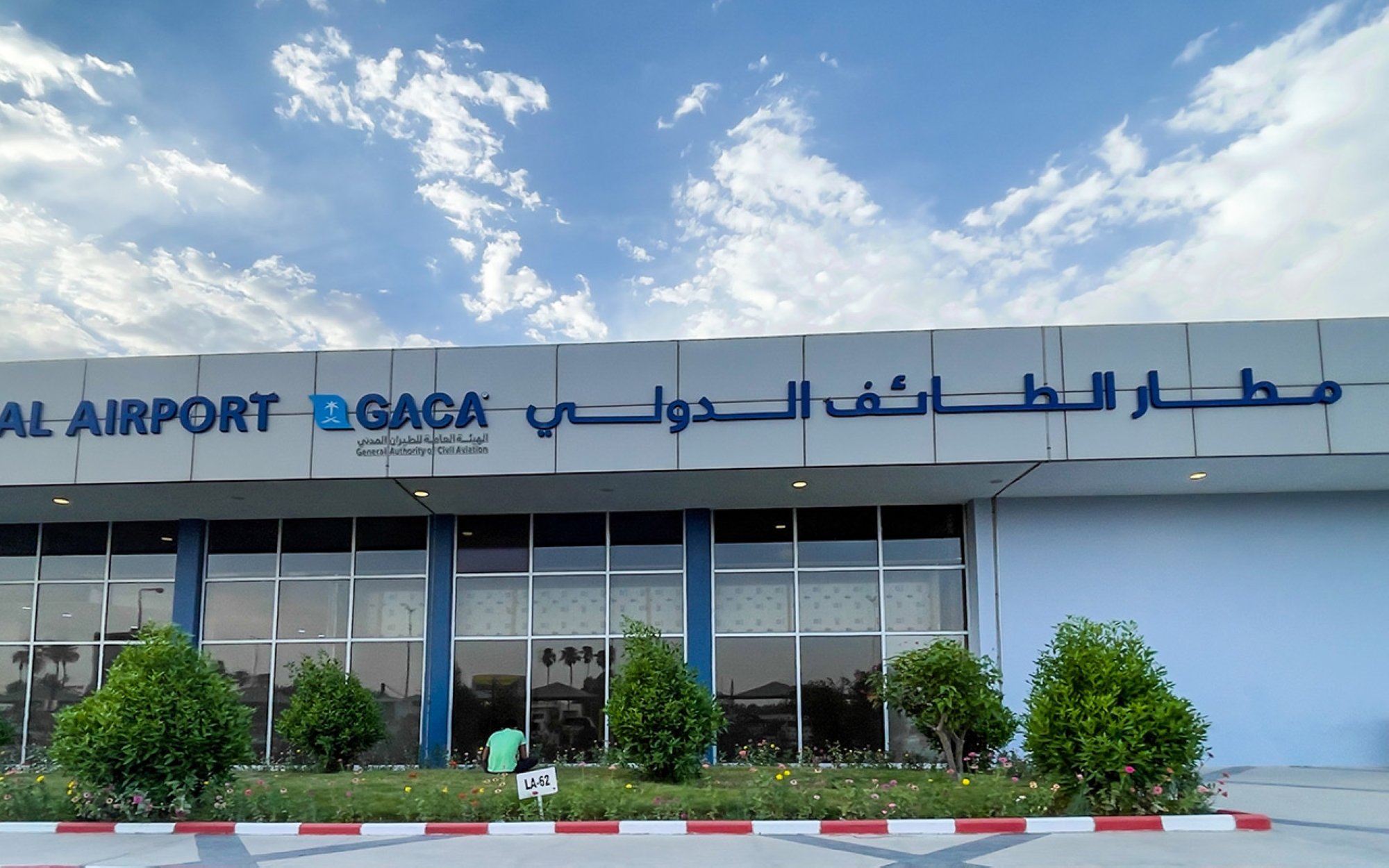
Transportation in Taif
Air transportation (Taif International Airport)
Abbreviated as TIF, Taif International Airport is one of the international airports in the Kingdom. It is located in Taif City, approximately twenty-seven km to the north. It can be accessed directly from inside the governorate via the new Taif Airport Road. Established in 1976, the airport serves both domestic and international flights in the Kingdom and is considered the aerial gateway to Taif City, a tourist destination for many visitors, both from within the Kingdom and abroad. It facilitates transit movement towards the Holy Sites during the Hajj and Umrah seasons. It is one of the top five busiest Saudi international airports in terms of air traffic. In 2019, approximately 10,867 flights, both international and domestic, landed and took off from this airport.
Taif Airport was transformed from a regional to an international airport in 2014. It underwent development and expansion as part of the new Taif projects associated with Saudi Vision 2030. As a result, the airport's passenger capacity increased to more than 5 million passengers, and its area expanded to approximately forty-eight million m.
Land Transportation (Aqabat al-Kurr)
Known as 'al-Hada Road' and 'Tal'at Kara,' it is a mountainous road (Aqabat) traversed by a paved roadway accessible to cars, connecting the city of Makkah al-Mukarramah and Taif Governorate from the west. The total length of the road is eighty-seven km.Trucks and large buses are prohibited from traversing this route throughout the year.
Historically, al-Hada Road was used for transportation between Makkah and Taif via Darb al-Jammalah. In 1958, the paved roadway for cars was constructed by order of King Saud Bin Abdulaziz Al Saud. During the reign of King Khalid Bin Abdulaziz Al Saud, an order was issued for the first expansion of al-Hada Road. The second expansion of the road was carried out under King Abdullah Bin Abdulaziz Al Saud, with a total cost exceeding SAR198 million. The project was completed in 2008.
Natural reserves
The Saja and Umm al-Rimth Natural Reserve
The Saja and Umm al-Rimth Natural Reserve, located northwest of the Mahazat al-Sayd protected area, covers an area of approximately 6,528.2 km. It is recognized by the World Commission on Protected Areas (WCPA) and is a part of the International Union for Conservation of Nature (IUCN). It was established to reintroduce the Macqueen's Bustards (Chlamydotis macqueenii), Arabian Oryx, and ostriches. It is characterized by its medium vegetation cover, which helps preserve the genetic resources of some endemic and rare mammals, birds, and reptiles in the reserve. Limited numbers of Macqueen's Bustards have been released in it, as a natural extension of the distribution of bustards between Mahazat al-Sayd Reserve and their other breeding habitats.
Imam Saud Bin Abdulaziz Royal Reserve
Located northeast of Taif Governorate, at a distance of 180 km, it is one of the seven royal reserves in the Kingdom. It was formerly known as Mahazat al-Sayd Reserve. On June 1, 2018, a Royal Order was issued to convert it into a royal reserve under the name 'Imam Saud Bin Abdulaziz Reserve.' The reserve contains many animals, including the Arabian wolf (Canis lupus arabs), Rüppell's fox (Vulpes rueppellii), sand cat (Felis margarita), various types of rodents, different kinds of birds, such as the bald eagle (Haliaeetus leucocephalus), the Eurasian griffon vulture (Gyps fulvus), and the Egyptian vulture (Neophron percnopterus), as well as several species of reptiles. In 1990, a reintroduction program began with the release of seventeen Arabian oryxes in the reserve. During 1990-1991, the Arabian gazelle (Gazella marica) and the bustard were also reintroduced there, and the red-necked ostrich was released into the reserve as well.
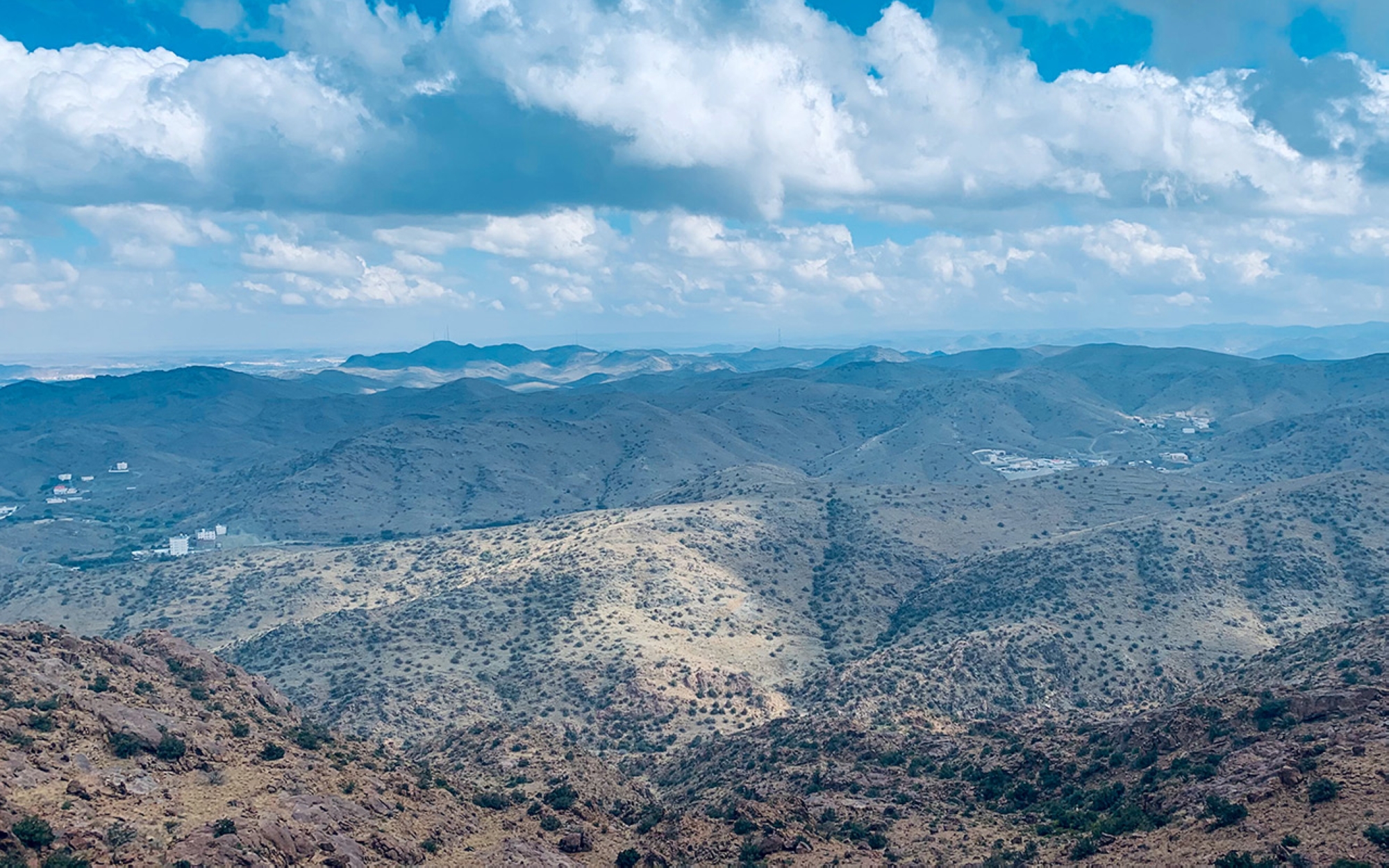
Tourism in Taif
Al-Ruddaf
It is an archaeological and tourist area in Taif Governorate, located in the southern part of Taif City. Its name is believed to be derived from the layered rocks spread over its plateaus. It is characterized by its moderate climate in summer and includes many gardens, a large part of which is designated for leisure and recreation. In al-Ruddaf, a collection of inscriptions and historical texts were discovered, including the name of a person written in Thamudic script, names of personalities, propaganda texts, poetic verses, proverbs, and sayings, in addition to sixty Islamic inscriptions dating back to the early Islamic eras.
The area includes al-Ruddaf Park, one of the largest parks in the Kingdom, spanning over five hundred thousand m. It hosts official and tourist seasonal celebrations and events. The park comprises nine gardens covering 155,000 m, all inspired by various civilizations, such as Andalusian, French, English, and desert environments. It features numerous sports and recreational facilities, including football, basketball, volleyball, and handball courts, along with a four thousand-m walking track flanked by supportive sports equipment and games, children's play areas surrounded by wooden shades for families, a group of cafes and restaurants with outdoor seating overlooking the lake, and an interactive fountain covering thirteen thousand m. Al-Ruddaf Park has received the Makkah Excellence Award in its third edition.
Al-Shafa
Al-Shafa is located in the southwest of Taif City, approximately twenty-five km away. The administrative area of al-Shafa region covers approximately 591 km and is situated at an elevation of about 2,500 m above sea level. Consequently, its climate is cool in summer and even colder in winter, with frequent rainfall and fog. The annual average rainfall in al-Shafa is about 323 mm. Al-Shafa is bordered to the north by al-Hada area, to the east by Liyah and Bani Sa'ad, and to the south and west by the western escarpment of the Sarawat Mountains. The area directly overlooks the lowlands and plains of Tihama to the west and is connected to Taif via a four-lane dual highway.
In al-Shafa, some agricultural crops are cultivated, such as local berries, al-Shafa figs, and vegetables. Roses and fragrant herbs are also grown in the area. It is famous for producing summer honey. There are parks, resorts, and some rest areas for youth and families, as well as restaurants and cafes. In al-Shafa area, there are also some government facilities and services, such as schools, clinics, and the municipality.
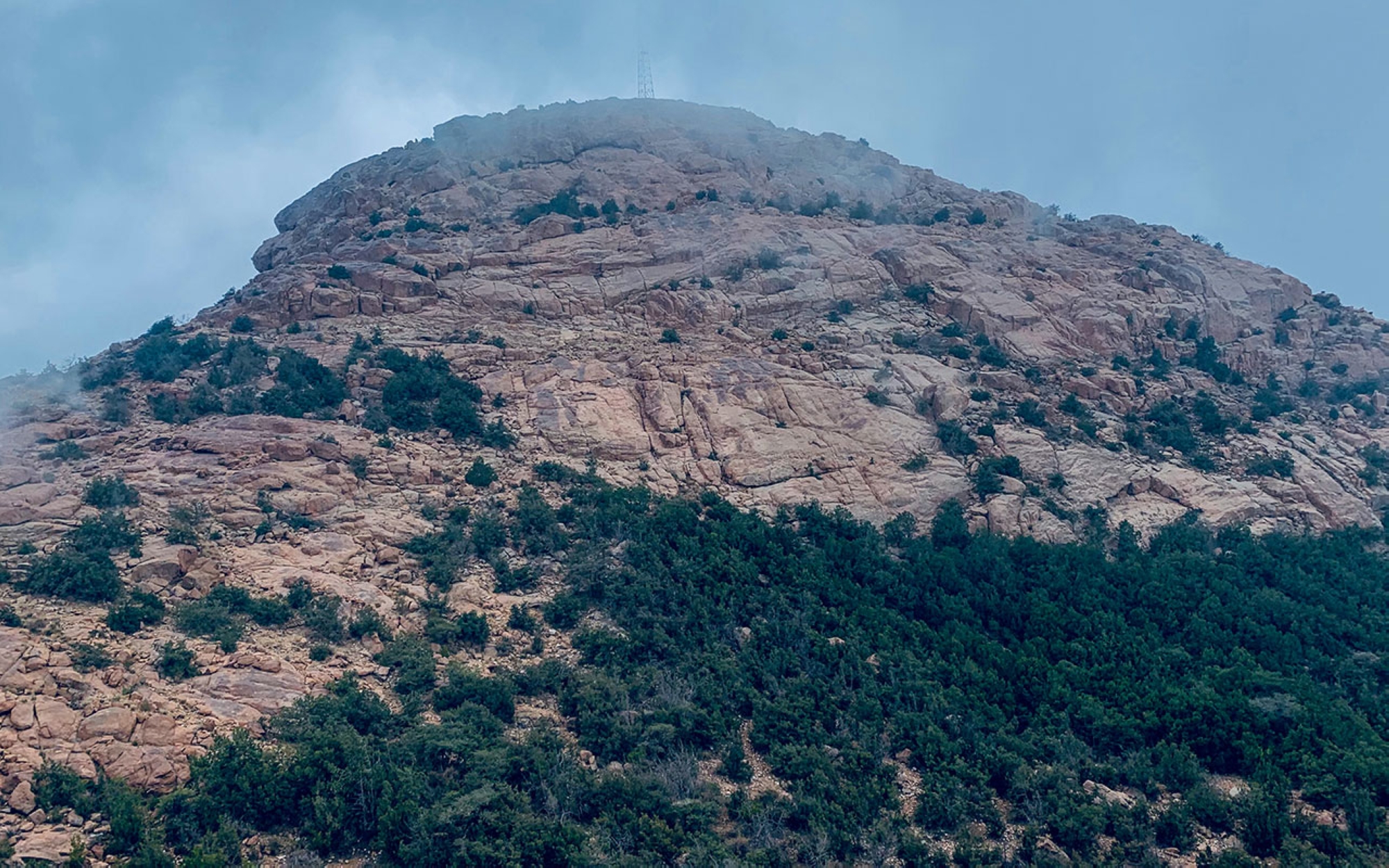
Al-Hada
Al-Hada Center is located in the western part of Taif City, about twenty km away. Wadi Muharram forms a natural boundary between it and the residential areas in Taif Governorate. The area covers about 207 km and is administratively affiliated with Taif Governorate. It is bordered to the east by Taif City and al-Hawiyah, to the west by the western escarpment of the Sarawat Mountains and al-Kurr, to the north by al-Sail Al-Kabeer area and Makkah al-Mukarramah, and to the south by al-Shafa area. Al-Hada is elevated about two thousand m above sea level, which contributes to its moderate climate. It is characterized by mild temperatures in summer and cool conditions in winter, along with frequent rainfall and fog. In al-Hada area, there are numerous resorts and furnished apartments, amusement parks, and electric games, as well as family and youth seating areas. It also offers government facilities and services, including schools for boys and girls, health clinics, municipal services, and other public services.
The developmental projects in Taif
Taif Technology Oasis
In collaboration with King Abdulaziz City for Science and Technology, the establishment of the Technology Oasis was announced on May 23, 2011. It is a smart technology city, working to enhance the efficiency and performance of urban services, reduce costs, and decrease resource consumption. It aims to support economic development and to develop real estate and infrastructure for equipping research and training facilities.
The focus of the Taif Technology Oasis spans several areas, including biotechnology and information technology, medical and health services, military and aviation, agriculture and agro-industry, perfumery, establishing databases facilities, and utilizing solar and wind energy as alternative and renewable sources of energy to conventional energy.
Taif Technology Oasis focuses on investing in educational facilities and fields, and establishing connections with other universities in Makkah al-Mukarramah Province, such as King Abdullah University of Science and Technology (KAUST), King Abdulaziz University, Taif University, and Umm al-Qura University. It also aims to benefit from international expertise and form agreements with global universities, such as Stanford University and the Massachusetts Institute of Technology (MIT).
The Taif Technology Oasis includes a project focused on the advanced cultivation, production, and harvesting of rapid-growth fodder. This initiative contributes to achieving food security in the Kingdom and reducing dependence on imports. The oasis is working on establishing six hundred bases for a solar cell power plant.
Related quizzes
Related articles

